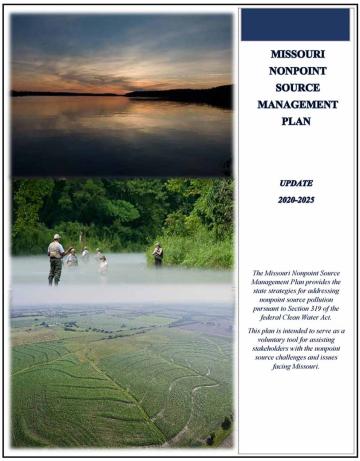
Developed by the department in concert with other state and federal partners, Missouri’s Nonpoint Source Management Plan outlines the state's strategies for addressing nonpoint source (NPS) pollution under Section 319 of the Clean Water Act (CWA). The plan is non-regulatory, serving as a voluntary tool to help stakeholders address nonpoint source challenges and issues in Missouri. Missouri's plan guides the state’s efforts in coordinating and prioritizing nonpoint source pollution reduction efforts and supporting state activities. As part of addressing statewide nonpoint source pollution concerns, Missouri’s plan prioritizes Missouri features vulnerable to degradation by nonpoint source pollution:
- Karst features – with more than 7,300 caves and 16,000 sinkholes
- 643,000 acres of wetlands
- 3 National Outstanding Resource Waters
- 44 State Outstanding Resource Waters
Plan History
Missouri’s Nonpoint Source Management Plan was first accepted by the U.S. Environmental Protection Agency in 1988, with subsequent minor and significant revisions accepted in 1996 and 2000. Additional minor revisions to individual sections were accepted by EPA in 2001, 2002, 2003 and 2004. In 2005, the accepted revisions were more complex and described EPA's eight key components of an effective nonpoint source pollution plan.
Minor revisions to the plan were completed between 2008 and 2010. Between 2011 and 2014, major revisions to the document were proposed and EPA accepted the plan in 2015. The update was part of the EPA Strategic Plan priority goal, where “By September 30, 2014, 100 percent of the states will have updated nonpoint source management programs that compare with the new Section 319 grant guidelines that will result in better targeting of resources through prioritization and increased coordination with the United States Department of Agriculture.”
Current Plan
Missouri’s current Nonpoint Source Management Plan is a five-year action plan that provides updates to the 2015-2019 plan. It describes how the state will improve and protect water quality impacted or threatened by nonpoint source pollution from 2020-2025. Updates to the plan include revisions to the goals, objectives, performance measures, milestones and strategies for achieving improved water quality. The goals and objectives were updated with input from key partnering stakeholders, including, but are not limited to, the Missouri Department of Health and Senior Services, Missouri Department of Conservation, Missouri Department of Transportation, U.S. Department of Agriculture's Natural Resources Conservation Service, U.S. Fish and Wildlife Service, EPA and several Missouri Department of Natural Resources programs.
The 2020-2025 plan is compatible with and supports the strategic plans of the department and many partnering agencies. The plan enhances protecting and restoring Missouri waters resource by implementing strategies to achieve nonpoint source goals, objectives and milestones. The plan’s priorities also help determine allocation of subgrant resources. Missouri’s current plan incorporates the most recent EPA guidance:
- Nonpoint Source Program and Grants Guidelines for States and Territories, April 12, 2013
- Section 319 Program Guidance: Key Components of an Effective State Nonpoint Source Management Program, November 2012
Over the next five years, the department's Section 319 Nonpoint Source Unit will continue to coordinate with partners on a regular basis, provide technical and financial assistance for watershed-based and effective water quality monitoring, and support implementation of management practices in watersheds with EPA-accepted 9-element watershed based plans.
Future Plan Updates
The department reviews and updates Missouri’s Nonpoint Source Management Plan every five years to incorporate national, state and partner goals, objectives or other nonpoint source initiatives. The department will begin holding a series of both in-person and virtual meetings to offer information on Missouri's plan and provide opportunities for public comments. When scheduled, information about those meetings will be provided below.

